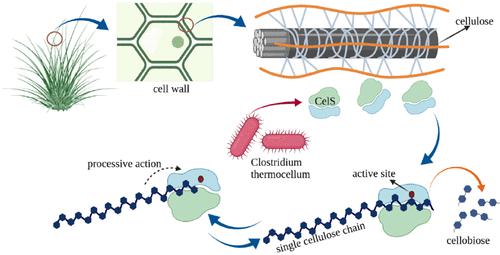当前位置:
X-MOL 学术
›
J. Chem. Inf. Model.
›
论文详情
Our official English website, www.x-mol.net, welcomes your feedback! (Note: you will need to create a separate account there.)
CelS-Catalyzed Processive Cellulose Degradation and Cellobiose Extraction for the Production of Bioethanol
Journal of Chemical Information and Modeling ( IF 5.6 ) Pub Date : 2022-06-01 , DOI: 10.1021/acs.jcim.2c00239 Sree Kavya Penneru 1 , Moumita Saharay 2 , Marimuthu Krishnan 3
Journal of Chemical Information and Modeling ( IF 5.6 ) Pub Date : 2022-06-01 , DOI: 10.1021/acs.jcim.2c00239 Sree Kavya Penneru 1 , Moumita Saharay 2 , Marimuthu Krishnan 3
Affiliation

|
Bacterial cellulase enzymes are potent candidates for the efficient production of bioethanol, a promising alternative to fossil fuels, from cellulosic biomass. These enzymes catalyze the breakdown of cellulose in plant biomass into simple sugars and then to bioethanol. In the absence of the enzyme, the cellulosic biomass is recalcitrant to decomposition due to fermentation-resistant lignin and pectin coatings on the cellulose surface, which make them inaccessible for hydrolysis. Cellobiohydrolase CelS is a microbial enzyme that binds to cellulose fiber and efficiently cleaves it into a simple sugar (cellobiose) by a repeated processive chopping mechanism. The two contributing factors to the catalytic reaction rate and the yield of cellobiose are the efficient product expulsion from the product binding site of CelS and the movement of the substrate or cellulose chain into the active site. Despite progress in understanding product expulsion in other cellulases, much remains to be understood about the molecular mechanism of processive action of these enzymes. Here, nonequilibrium molecular dynamics simulations using suitable reaction coordinates are carried out to investigate the energetics and mechanism of the substrate dynamics and product expulsion in CelS. The calculated free energy barrier for the product expulsion is three times lower than that for the processive action indicating that product removal is relatively easier and faster than the sliding of the substrate to the catalytic active site. The water traffic near the active site in response to the product expulsion and the processive action is also explored.
中文翻译:

CelS 催化的连续纤维素降解和纤维二糖提取用于生产生物乙醇
细菌纤维素酶是有效生产生物乙醇的有力候选者,生物乙醇是一种有前途的化石燃料替代品,来自纤维素生物质。这些酶催化植物生物质中的纤维素分解成单糖,然后分解成生物乙醇。在没有酶的情况下,纤维素生物质由于纤维素表面上的耐发酵木质素和果胶涂层而难以分解,这使得它们无法水解。纤维二糖水解酶 CelS 是一种微生物酶,可与纤维素纤维结合,并通过重复的加工切割机制将其有效地切割成单糖(纤维二糖)。影响催化反应速率和纤维二糖产量的两个因素是从 CelS 的产物结合位点有效排出产物以及底物或纤维素链移动到活性位点。尽管在了解其他纤维素酶的产物排出方面取得了进展,但关于这些酶的持续作用的分子机制仍有许多有待了解。在这里,使用合适的反应坐标进行非平衡分子动力学模拟,以研究 CelS 中底物动力学和产物排出的能量学和机制。计算出的产物排出的自由能垒比加工作用的自由能垒低三倍,表明产物去除比底物滑动到催化活性位点相对更容易和更快。
更新日期:2022-06-01
中文翻译:

CelS 催化的连续纤维素降解和纤维二糖提取用于生产生物乙醇
细菌纤维素酶是有效生产生物乙醇的有力候选者,生物乙醇是一种有前途的化石燃料替代品,来自纤维素生物质。这些酶催化植物生物质中的纤维素分解成单糖,然后分解成生物乙醇。在没有酶的情况下,纤维素生物质由于纤维素表面上的耐发酵木质素和果胶涂层而难以分解,这使得它们无法水解。纤维二糖水解酶 CelS 是一种微生物酶,可与纤维素纤维结合,并通过重复的加工切割机制将其有效地切割成单糖(纤维二糖)。影响催化反应速率和纤维二糖产量的两个因素是从 CelS 的产物结合位点有效排出产物以及底物或纤维素链移动到活性位点。尽管在了解其他纤维素酶的产物排出方面取得了进展,但关于这些酶的持续作用的分子机制仍有许多有待了解。在这里,使用合适的反应坐标进行非平衡分子动力学模拟,以研究 CelS 中底物动力学和产物排出的能量学和机制。计算出的产物排出的自由能垒比加工作用的自由能垒低三倍,表明产物去除比底物滑动到催化活性位点相对更容易和更快。



























 京公网安备 11010802027423号
京公网安备 11010802027423号